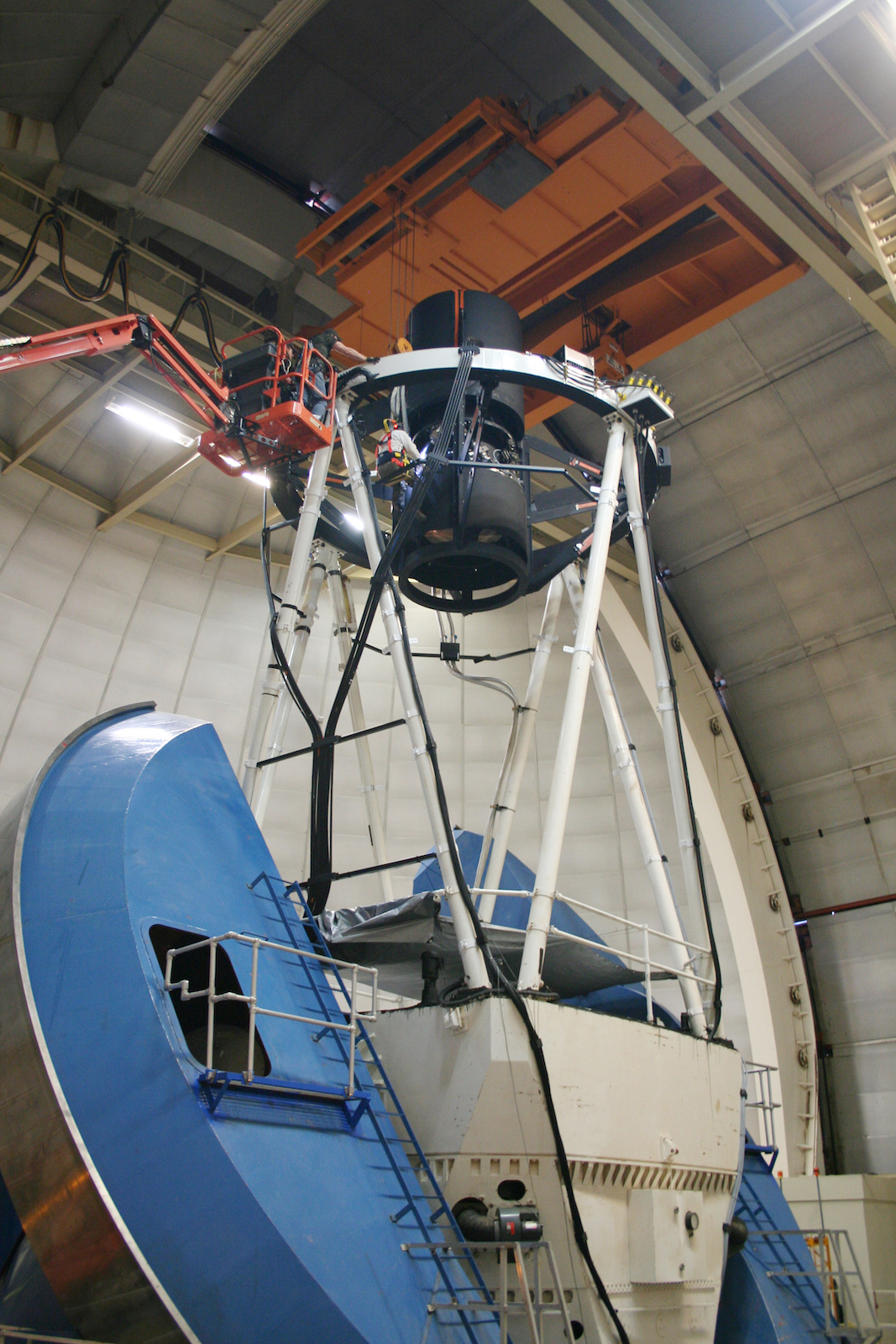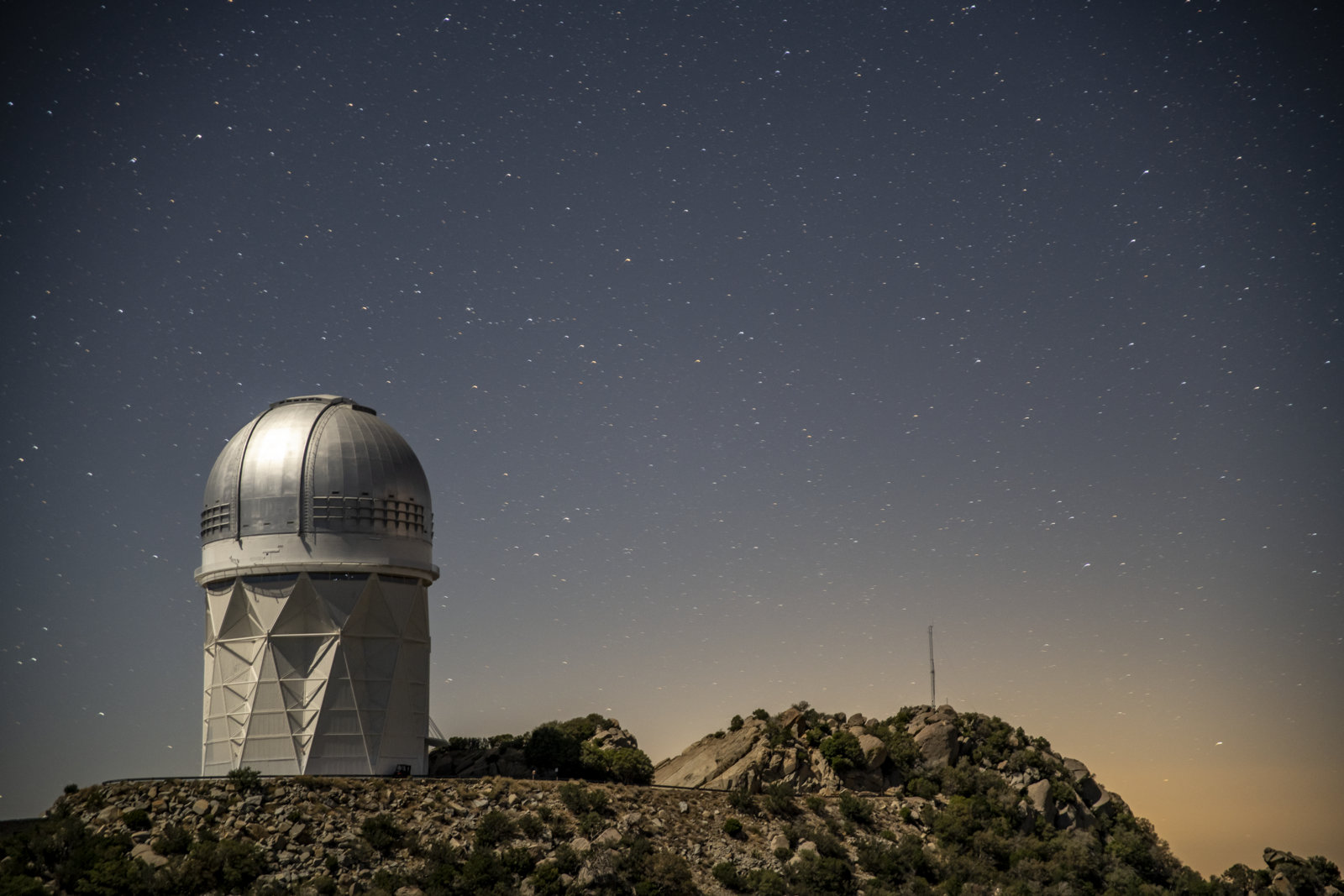Today Kitt Peak Visitor Center celebrated 60 years of greeting visitors to the U.S. National Science Foundation Kitt Peak National Observatory. Since opening in 1964, the Visitor Center has welcomed more than two million guests to the mountain in its mission to inspire a sense of wonder and awe about the Universe through exhibits, daytime tours and nighttime public programs.
Tag: Kitt Peak National Observatory
El Centro de visitas de Kitt Peak celebra 60 años compartiendo las maravillas del cielo nocturno
El Centro de Visitas de Kitt Peak celebra 60 años de funcionamiento en el Observatorio Nacional de Kitt Peak de la Fundación Nacional de Ciencias, donde desde su apertura en 1964 ha dado la bienvenida a más de dos millones de personas que han visitado el complejo para conocer su misión de inspirar el asombro y la admiración por el Universo, mediante exposiciones, visitas diurnas y programas públicos nocturnos.
Astrónomos descubren inusual exoplaneta gigante con una órbita extremadamente rara
Con la ayuda del telescopio WIYN de 3,5 metros ubicado en Kitt Peak, Arizona, los astrónomos lograron descubrir la órbita extrema de un exoplaneta que está camino a convertirse en un Júpiter caliente. Además de seguir una de las órbitas más alargadas de todos los exoplanetas, el cuerpo celeste órbita su estrella al revés, lo que da indicios sobre el misterio de la evolución de los Júpiter calientes.
WIYN 3.5-meter Telescope at Kitt Peak Discovers Extremely Strange Orbit of Rare Exoplanet
Using the WIYN 3.5-meter telescope at the U.S. National Science Foundation Kitt Peak National Observatory, a Program of NSF NOIRLab, astronomers have discovered the extreme orbit of an exoplanet that’s on its way to becoming a hot Jupiter.
Kitt Peak National Observatory Hosts Open Night for the Tohono O’odham Nation
More than 70 NOIRLab staff volunteers welcomed hundreds of visitors from the Tohono O’odham Nation to Kitt Peak National Observatory to enjoy a night of telescope viewings, cultural performances, and educational activities.
Revelan detallada panorámica de 11 mil millones de años hacia el pasado del Universo
Astrónomos de diversas partes del mundo están realizando un análisis inicial de los datos del primer año de estudio del Instrumento Espectroscópico de Energía Oscura, que lleva a cabo un sondeo de 5 años para crear el mapa en 3D más grande que se haya hecho sobre el Universo. Utilizando el espectro de las galaxias cercanas y de cuásares distantes, los astrónomos reportaron que lograron medir la historia de la expansión del Universo con la mayor precisión jamás alcanzada, proporcionando un panorama sin precedentes sobre la naturaleza de la energía oscura y su efecto en la estructura a gran escala del Universo.
DESI Looks 11 Billion Years Into the Past to Reveal Most Detailed View Ever of the Expanding Universe
The Dark Energy Spectroscopic Instrument is conducting a five-year survey to create the largest 3D map of the Universe ever. Astronomers are now performing initial analysis of the survey’s first-year data. Using spectra of nearby galaxies and distant quasars, astronomers report that they have measured the expansion history of the Universe with the highest precision ever, providing an unprecedented look at the nature of dark energy and its effect on the Universe’s large-scale structure.
Observatorio Nacional Kitt Peak reinicia visitas del público
A partir del viernes 22 de septiembre, el Observatorio Nacional de Kitt Peak comenzará un programa de reapertura limitada para dar la bienvenida al público que podrá visitar sus instalaciones, luego de más de tres años de cierre como resultado de la pandemia de COVID-19 y del incendio Contreras. La histórica cima de KPNO dará la bienvenida a los visitantes para que disfruten de sus visitas guiadas diurnas y de los programas de observación nocturna.
Kitt Peak National Observatory Will Host Soft Reopening 22 September
Kitt Peak National Observatory will begin a limited reopening program to welcome the public through its doors and domes starting Friday 22 September.
Estudio registra casi dos millones de galaxias, cuásares y estrellas en su publicación preliminar
Casi dos millones de objetos, que incluyen galaxias distantes, cuásares y estrellas, se encuentran en la publicación preliminar de datos del Instrumento Espectroscópico de Energía Oscura (DESI), del Laboratorio Nacional Lawrence Berkeley, en el Observatorio Nacional de Kitt Peak, un Programa de NOIRLab de NSF. Estos datos ayudarán a los investigadores a estudiar la historia de la expansión del Universo con un detalle sin precedentes y explorar otras áreas de la investigación astrofísica de frontera. DESI es financiado por el Departamento de Energía de los Estados Unidos y administrado por el Laboratorio Berkeley.
Nearly Two Million Galaxies, Quasars, and Stars Contained in DESI Early Data Release
Nearly two million objects, including distant galaxies, quasars, and stars, comprise the early data release from the Lawrence Berkeley National Laboratory Dark Energy Spectroscopic Instrument (DESI) at Kitt Peak National Observatory, a Program of NSF’s NOIRLab. These data will help researchers study the expansion history of the Universe in unprecedented detail and explore other frontier areas of astrophysical research. DESI is funded by the US Department of Energy and managed by Berkeley Lab.
‘Marshmallow’ World Orbiting a Cool Red Dwarf Star
A gas giant exoplanet with the density of a marshmallow has been detected in orbit around a cool red dwarf star by a suite of instruments, including the NASA-funded NEID radial-velocity instrument on the WIYN 3.5-meter Telescope at Kitt Peak National Observatory, a Program of NSF’s NOIRLab. The planet, named TOI-3757 b, is the fluffiest gas giant planet ever discovered around this type of star.

Now Complete, Telescope Instrument is Poised to Begin Its Search for Answers About Dark Energy
Even as the Dark Energy Spectroscopic Instrument, or DESI, lies dormant within a telescope dome on a mountaintop in Arizona, due to the COVID-19 pandemic, the DESI project has moved forward in reaching the final formal approval milestone prior to startup.

DESI Team Prepares for Telescope Instrument’s Restart after Unexpected Shutdown
Despite a temporary shutdown of the Dark Energy Spectroscopic Instrument in Arizona – which was in its final stages of testing in preparation to begin mapping millions of galaxies in 3D when the pandemic struck – a variety of project tasks are still moving forward.

Looking Up From the Mountaintop: Q&A with a Telescope Instrument’s Lead Observer
In this Q&A Satya Gontcho A Gontcho, a lead observer for the Dark Energy Spectroscopic Instrument (DESI), shares her experiences at the DESI site near Tucson, Arizona, including evening observing stints to run through detailed checklists and probe how the instrument’s components are working.